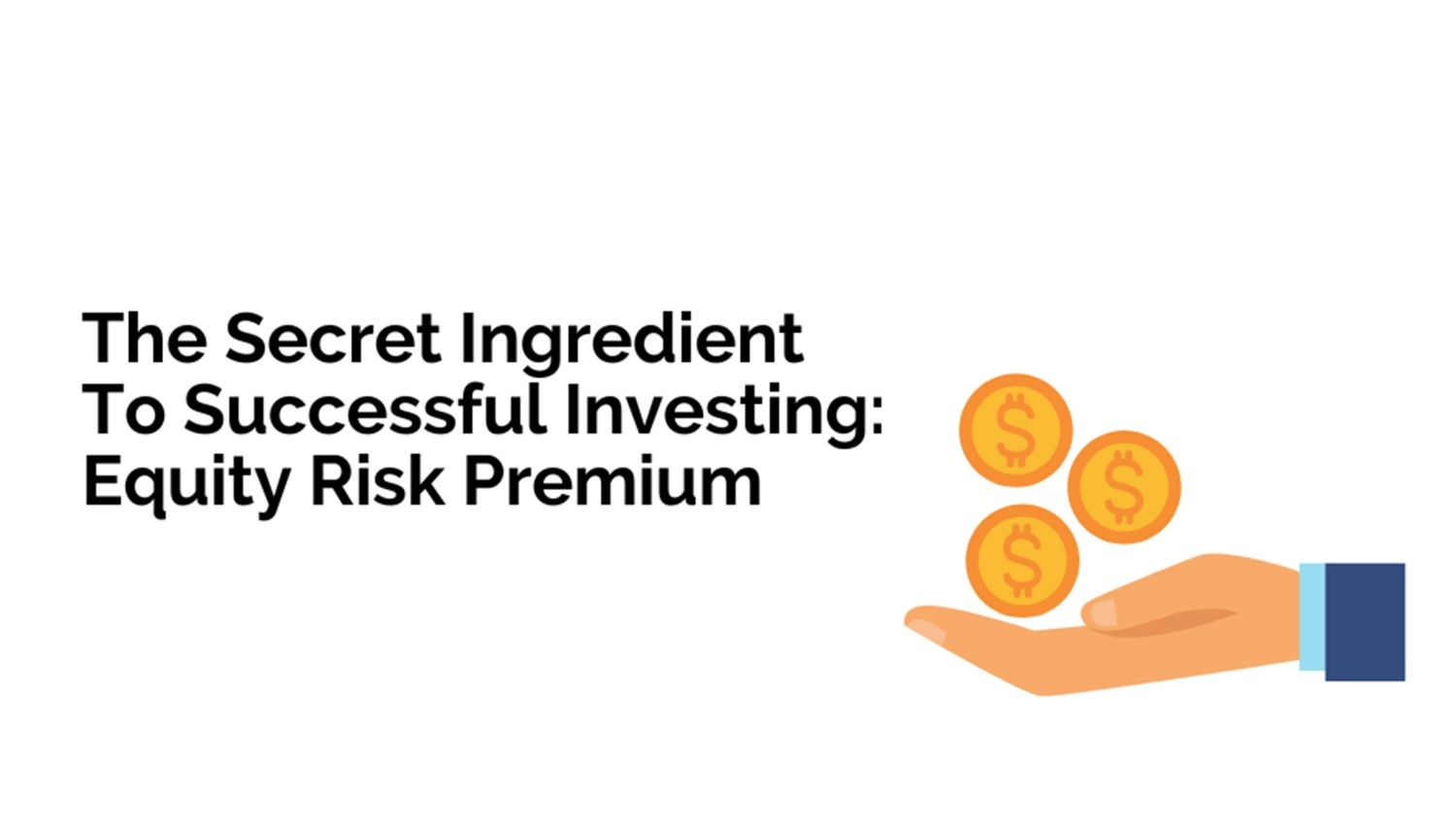Understanding the Equity Risk Premium in Investing

If you want to make smarter investment choices, you must understand 'Equity Risk Premium.'
This might sound like finance jargon or only about investing in equities, but it's not as complex or only about equities as you think.
So why is this important?
Well, because understanding how much additional profit you could potentially get from taking on more risk can guide your investment decisions effectively and efficiently.
It also helps you assess and rejig your asset allocation plan.
What is Equity Risk Premium?
The equity risk premium represents the additional return an investor expects to receive from investing in stocks over a risk-free asset, typically government bonds. It is the reward for bearing the extra risk associated with the stock market's volatility. This extra return on one’s investments draws investors to choose equities over relatively safer assets.
Calculating Equity Risk Premium
Calculating the equity risk premium involves comparing the expected returns from the stock market to the yield of government bonds. While the exact method can vary, a common approach is to use historical data to estimate future premiums.
This involves analysing past stock market returns and subtracting the risk-free rate from them.
The current yield on the benchmark 10-year government bond is 7.04%, and the average annual return for the Nifty 50 may be estimated at 12.69%. That would place the equity risk premium at 5.65%
Remember that past performance is not a surefire way of estimating future returns, but it can be a statistical tool for making decisions.
Equity Risk Premium Formula
The Equity Risk Premium (ERP) is simply the difference between the expected return from the stock market and the risk-free rate, typically the yield on government bonds.
ERP = Expected Market Return − Risk-Free Rate
For example, if the expected return on the stock market is 12.69%, and the current 10-year government bond yield is 7.04%, the equity risk premium would be 5.65%.
This extra return compensates investors for the additional risk of equities compared to safer government securities.
While historical returns can be used for estimates, it’s essential to remember that past performance doesn’t guarantee future results. However, ERP provides a valuable benchmark for evaluating whether stocks are reasonably priced and for calibrating your investment decisions based on risk and potential reward.
What is the Risk Premium Component in CAPM?
The risk premium in the Capital Asset Pricing Model (CAPM) represents the additional return an investor expects for taking on the market risk beyond the risk-free rate.
Mathematically, it is the difference between the expected market return and the risk-free rate. This premium compensates investors for bearing systematic risk, which cannot be diversified away.
In the CAPM formula, the risk premium is multiplied by an asset’s beta, a measure of its sensitivity to market movements, adjusting the premium according to the asset’s risk relative to the overall market.
Understanding this component is crucial for determining whether an investment provides a suitable risk-return tradeoff.
When and How to Use Equity Risk Premium in Investment Decisions
The equity risk premium is more than just a number; it reflects the market's sentiment towards risk and reward. It reflects the market's collective judgment on the premium worth paying for the potential higher returns of equity investments over risk-free securities.
A question that invariably surfaces before investing in a stock is: Am I entering at a favourable price point?
Answering this requires assessing the stock's intrinsic value.
Similarly, the implied equity risk premium acts as a strategic valuation tool, enabling investors to evaluate whether a stock or index investment is justified.
Portfolio Diversification
The equity risk premium helps investors understand the potential rewards of diversifying their portfolios. By balancing investments between high-risk stocks and risk-free assets, investors can optimize their returns while managing risk. Equity risk premium offers insights into market volatility and risk.
Investors can use this information to adjust their risk tolerance levels and investment horizons, aligning their portfolios with their financial goals and risk appetite. Comparing the equity risk premium to bond yields can offer valuable insights. While bonds provide a fixed return, stocks offer growth potential offset by higher risk.
Focusing on the equity risk premium can guide investors towards more profitable, long-term investment strategies.
Factors Influencing Equity Risk Premium
- Economic Conditions: Economic growth and stability significantly influence investor confidence, which in turn impacts the risk premium; turbulent economies typically see higher premiums.
- Interest Rates: Higher risk-free rates (like government bonds) lower the equity risk premium, while lower rates increase it.
- Market Volatility: Greater price fluctuations boost the premium as investors demand more compensation for risk.
- Investor Sentiment: Increased risk aversion leads to higher premiums; optimistic moods tend to decrease the premium.
- Political and Regulatory Risks: Political instability or unfavourable policies raise perceived risk, pushing premiums higher.
- Liquidity: Markets or stocks with lower liquidity require higher premiums due to the difficulty in buying or selling assets quickly.
- Time Horizon: Longer investment horizons generally increase the risk premium required to compensate for greater uncertainty.
Understanding these factors helps investors gauge the reward for taking extra risk in equities and adjust portfolios accordingly.
Making Smart Investment Decisions with Equity Risk Premium
When the Equity Risk Premium is high, it indicates the possibility of increased gains, albeit with greater volatility and risk. Conversely, a lower one points to a more cautious investment approach, offering steadier, albeit lesser, expected returns.
By understanding and utilising this metric, investors can make more informed decisions, striking the right balance between risk and return.
Similarly, the implied equity risk premium acts as a strategic valuation tool, enabling investors to evaluate whether a stock or index investment is justified.
Whether you're a novice investor or a seasoned professional, integrating the equity risk premium into your investment strategy can help you achieve a more prosperous financial future.
Frequently Asked Questions
Why is the Equity Risk Premium important?
The Equity Risk Premium (ERP) is a crucial concept because it quantifies the extra return investors expect for taking the risk of investing in equities over risk-free assets like government bonds. It helps investors assess whether the potential rewards justify the risks, guiding them to make smarter choices and setting realistic expectations for long-term returns.
How does the Equity Risk Premium affect investment decisions?
ERP influences portfolio allocation by signalling the attractiveness of stocks versus safer investments. A higher premium encourages more equity exposure for potential growth, while a lower premium suggests caution. It acts as a benchmark to balance risk and reward, helping investors tailor their strategy to their risk tolerance and financial goals.
Does the equity premium equate to the risk premium?
Equity risk premium is a type of risk premium specific to equities, representing additional returns expected over risk-free assets. Risk premium, more broadly, refers to the extra return required for any risky asset over a risk-free option. So, while related, equity risk premium is a subset within the general concept of risk premium.
What affects the premium for equity risk?
Several factors impact the equity risk premium, including economic conditions, interest rates, market volatility, and investor sentiment. When markets are uncertain or volatile, the premium tends to rise as investors demand a higher reward for taking on added risk. Conversely, stable or optimistic conditions often lower the premium.
What is the Current Equity Risk Premium?
As per recent data, with a 10-year government bond yield around 7.04% and the Nifty 50’s average return estimated near 12.69%, the equity risk premium stands approximately at 5.65%. This figure, derived from historical averages, indicates the expected excess return from equities over safer government bonds.
Can the Equity Risk Premium be negative?
Though rare, the equity risk premium can turn negative if expected stock returns fall below risk-free rates, such as during extreme market pessimism or when bond yields spike unexpectedly. Negative premiums indicate that investors see stocks as less attractive than safe assets, signaling market caution.
What does a High Equity Risk Premium mean?
A high equity risk premium suggests investors expect greater compensation for equity risk, often reflecting market anxiety or higher volatility. It may indicate buying opportunities as stocks are perceived as undervalued. However, it also means accepting heightened risk and potential price swings in pursuit of higher returns.
